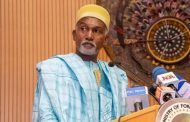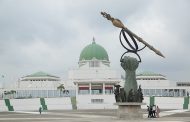By Jon Allsop
Nothing appears to have happened to the received wisdom that half or quarter truths acting as bodyguards of the larger truth is the first condition of war, be it between what humorist and incumbent Nigerian Minister for Education, Mallam Adamu Adamu, used to call Moschington (Moscow and Washington) of the Cold War years or even of today. This entertaining repertoire from the Columbian Journalism Review seems to speak to that!
 Late last week, a pair of major national-security stories sparked testy exchanges between the Biden administration and reporters who cover it. At a briefing, Ned Price, a State Department spokesperson, told reporters that Russia may soon fabricate a “propaganda video”—complete with “graphic scenes of false explosions” and “crisis actors pretending to be mourners”—as a pretext to invade Ukraine, leading Matthew Lee, a diplomatic writer at the Associated Press, to push back. “Crisis actors?” Lee asked. “Really? This is, like, Alex Jones territory you’re getting into now. What evidence do you have to support the idea that there is some propaganda film in the making?” Price said that he was referring to declassified US intelligence; when Lee asked where he might find it, Price said “I just delivered it,” and invited Lee to print out a transcript. “That’s not evidence,” Lee objected. “That’s you saying it.” After several more minutes of back and forth, Price decided to move on, telling Lee that if he wanted to doubt the US government and “find solace in information that the Russians are putting out, that is for you to do.”
Late last week, a pair of major national-security stories sparked testy exchanges between the Biden administration and reporters who cover it. At a briefing, Ned Price, a State Department spokesperson, told reporters that Russia may soon fabricate a “propaganda video”—complete with “graphic scenes of false explosions” and “crisis actors pretending to be mourners”—as a pretext to invade Ukraine, leading Matthew Lee, a diplomatic writer at the Associated Press, to push back. “Crisis actors?” Lee asked. “Really? This is, like, Alex Jones territory you’re getting into now. What evidence do you have to support the idea that there is some propaganda film in the making?” Price said that he was referring to declassified US intelligence; when Lee asked where he might find it, Price said “I just delivered it,” and invited Lee to print out a transcript. “That’s not evidence,” Lee objected. “That’s you saying it.” After several more minutes of back and forth, Price decided to move on, telling Lee that if he wanted to doubt the US government and “find solace in information that the Russians are putting out, that is for you to do.”
Meanwhile, on Air Force One, Jen Psaki, the White House press secretary was telling a gaggle of reporters about a raid that Biden had just authorized to take out Hajji Abdullah, the leader of ISIS, in Syria when Ayesha Rascoe, of NPR, asked her whether the administration would publish any evidence for her claim that Abdullah detonated a bomb as US forces closed in, killing himself, a woman, and three children. “There may be people that are skeptical of the events that took place and what happened to the civilians,” Rascoe noted. “Skeptical of the US military’s assessment when they went and took out the leader of ISIS?” Psaki asked. “That they are not providing accurate information and ISIS is providing accurate information?” Rascoe quickly clarified that this was not at all what she meant. “The US has not always been straightforward about what happens with civilians,” she said. “And, I mean, that is a fact.”
Psaki went on to assure Rascoe that it would take time for the Pentagon to make a “final assessment,” and that, in doing so, officials would provide “every detail they can.” But the damage was done. The dismissiveness of Psaki’s original response, coupled with Price’s near-simultaneous bout with Lee, sparked outrage among reporters at major outlets, who bridled, in particular, at their dual insinuations of disloyalty. Felicia Sonmez, of the Washington Post, noted that “asking for proof to back up government statements” is a journalist’s job, and that doing so “does not mean one believes propaganda put out by US adversaries”; Politico’s Alexander Ward wrote, meanwhile, that the administration could have touted a pair of intelligence “wins,” but instead “bumbled the message, raised the hackles of a skeptical press, and bullied the conversation into a Bush-era ‘you’re either with or against us’ false dichotomy.” Psaki complained that Sonmez had quoted her out of context, but quickly found herself doing cleanup, calling Rascoe to apologize if she felt her question was undervalued. Price, for his part, emphasized that he was unable to say anything that might compromise intelligence sources and that the reporters in his briefing room know that, but also accepted that this is an “unsatisfactory balance for journalists,” and said that he had since called Lee to express his respect for him.

Ned Price
Both officials stressed that they have committed to holding regular briefings, and that they respect the press and invite tough questions. Regular briefings are welcome, especially after they dried up under the Trump administration, at both the White House and State Department. But they’re really a bare minimum; what officials say at them, and in other settings, matters much more, especially when it comes to matters of life and death. There, already, the Biden administration’s record is highly checkered. Last summer, US officials bragged that a drone attack it executed in Kabul was a “righteous strike” that had stopped ISIS from bombing an airport amid the US evacuation, but Western news organizations soon reported that the strike had actually killed ten people—none of them terrorists, seven of them children. Sources close to the ground have already challenged the White House account of last week’s Abdullah raid in Syria, reporting more civilian deaths than US officials have acknowledged, including those of six children, and that at least one US helicopter engaged in heavy gunfire.
Psaki and others have cast Biden’s professed respect for the press as a stark contrast to Trump’s treatment of reporters. It is. But officials getting things wrong in the fog of war—or, often, overtly lying through it—is a genuinely bipartisan practice that transcends administration. Bush’s administration lied to the press about the rationale for the war in Iraq; in his 2019 “Afghanistan Papers” series based on secret government records, Craig Whitlock, of the Post, revealed the extent to which the Bush, Obama, and Trump administrations all lied about the progress of the war in Afghanistan. (Whitlock’s reporting sadly got a bit lost in the crazed Trump news cycle, but it reappeared in book form last summer and climbed to second place on the Times’s bestseller list.) Since then, the Times has undertaken comparably ambitious reporting on official war lies. In her recent “Civilian Casualty Files” series, Azmat Khan also used a trove of secret records to demonstrate a pattern of “opacity and impunity” in the Pentagon’s handling of deaths caused by US airstrikes in Iraq and Syria under Obama and Trump. Khan and colleagues reported last month that the US bombed a Syrian dam in 2017 even though it was on a “no-strike” list—a fact that officials dismissed, at the time, as “crazy reporting.” The Times has been particularly aggressive, too, in following up on last summer’s Kabul strike, even obtaining rare drone footage of the attack after filing a lawsuit.
In the run-up to the Iraq war, many reporters and pundits at major outlets—not least the Times—bought Bush’s casus belli hook, line, and sinker. It’s tempting to conclude, after being burned so badly, that the media learned its lessons. But it’s hard to draw clean, straight lines here. Not everyone in the media parroted the Bush administration’s lies at the time. And not everyone applies sufficiently rigorous skepticism to US intelligence claims in the present. Journalists like Whitlock and Khan have done excellent, highly time- and resource-intensive enterprise reporting to demonstrate the scale of official deceptions; journalists like Lee and Rascoe have asked sharp questions. But quick-turn formats—daily news stories, headlines, tweets, cable-news segments, and so on—still too often relay what “officials say” without as prominently telling readers much about the evidence, or lack thereof, for their statements. The problem reminds me, in some ways, of the media reckoning over police lies that intensified following the murder of George Floyd in 2020. A lot of astute articles noted the tactics police departments use to set misleading narratives. Many others continue, even now, to indulge them.
As Charlie Savage, of the Times, put it last week in an article about Price and Psaki’s remarks, “what officials say is news to be reported, but it is often impossible to independently verify the details right away.” The latter task does indeed take time, making it all the more important that the first draft of history contain rich and prominent context about the evidentiary record to that point and—where appropriate—the ample historical justification for skepticism of the official line. This challenge is especially urgent with regards to Ukraine, not just because the stakes are immediate and growing, but since, as I wrote recently, the US and its allies are detailing supposed Russian plots—in a break from past practice—as part of a conscious strategy of information warfare. This doesn’t necessarily mean that the plots aren’t real. But if your strategy involves sharing information, you can’t dismiss anyone who asks for more of it as a dupe for the bad guys. That starts to look like information warfare in itself.




























